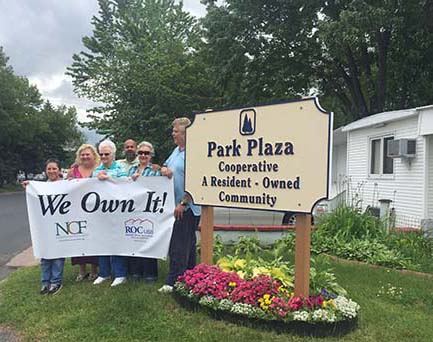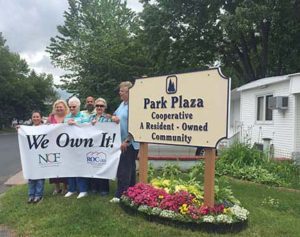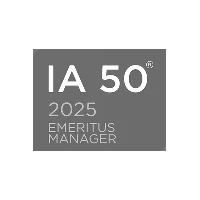By Alison Powers, Program Officer
More than 10,000 low-and-moderate income homeowners are sleeping better at night thanks to our partner ROC USA. Instead of worrying about rent increases or land sales that might force them to move, residents of manufactured-home communities (what many commonly refer to as mobile home parks) across the country have purchased their land and put down roots through ROC USA’s cooperative ownership program.
Since 2008, the nonprofit social venture’s innovative model has spun off 182 resident-owned communities in 14 states, ranging in size from eight to 300 dwellings. The 10,000th home was recently secured at Turnpike Park Cooperative in Westborough, Mass.
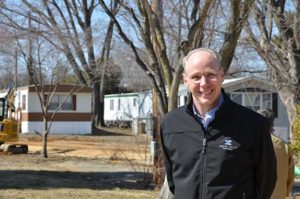
A Wealth of Benefits
One of the many reasons that residents like the program is because it stabilizes costs. “In commercially-owned properties, rents will continue to go up,” says Bradley. “Factors outside of community control, like property tax increases, can go up with a co-op, but there is no longer profit margin built into their rent.”
And owners of the homes benefit too. Studies have documented that homes in cooperatively-owned manufactured communities sell for about 16% higher than homes in investor-owned communities.
Another benefit is having control of the land. Homeowners are not subject to increasing fees put in place by the land owner. “The co-op model of ownership is an excellent solution to a basic problem that anyone who owns the home and rents the lot faces,” says Bradley. “By having ownership of the land, you maintain control.”
Cooperative communities also allow older residents to age in their homes surrounded by the community they have known for years. “If they have the time and the inclination and an opportunity to purchase the community, it is a very good bet that they’ll be very interested,” he says. “Younger retirees are often interested in securing their properties for the long term; they see themselves staying there a good long while.”
A less tangible but still important benefit is community connectedness and civic engagement, says Bradley. “I’ve visited 40 or 50 communities, and I always walk around with the board of directors,” he says. “They tell me the same story, ‘Before ROC USA, I knew the people on either side of my house and maybe a few others, but going through the purchase process, I’ve met so many more.’ And they start to point out that the Jones family lives there and the Smiths are over there. That changes their quality of life.”
For Park Plaza Cooperative resident-owner Natividad, becoming a resident-owned community – and the fifth co-op in the state of Minnesota – has meant affordable and sustainable housing not just for her family, but for all the families in the community.
“If (ROC USA) hadn’t come around, I don’t know where we’d be right now. I can’t imagine where 80-plus families would have gone had this not happened.”
And the move to ownership has drastically improved the community. “People have way changed. They’ve opened up, they’ve gotten to know each other. Should somebody need care within the home, we’re able to help them. It’s just become really close where before it wasn’t like that at all.”
ROC USA provides homeowners with the opportunity, training and financing to purchase and manage their communities. “We provide access to financing that gives co-ops an ability to pay fair market value,” says Bradley. “We empower them to act like a deep-pocketed investor – something lower income homeowners don’t normally have.”
Helping More Homeowners
All of ROC USA’s 182 co-op-run communities are still operating successfully, and this success has Bradley optimistic about the future. Within the next three years, ROC USA’s strategic plan prioritizes expanding into three to five new states, says Bradley, as well as expanding the economic benefits of living in a resident-owned community. For example, ROC USA plans to provide access to quality replacement homes, infrastructure improvements, and health and safety resources for residents. The organization is also planning a significant amount of training and education.
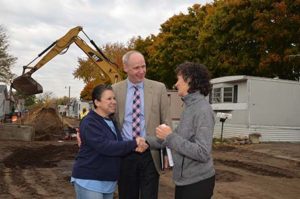
Natividad also points to ROC USA’s partnership as leverage in getting other lenders for construction projects. Without their ongoing support, she’s not sure Park Plaza could have navigated the lending process it recently finished for sewer upgrades.
Thirty years of co-op support
“As a founding investor in ROC USA, we are proud of their tireless efforts to help increase resident-owned communities across this country,” said Ellis Carr, CEO of Capital Impact Partners. “Supporting and scaling cooperatives has been a fundamental priority for CIP for 30 years, and by working with ROC USA, and providing financing to manufactured home communities who adopt the co-op model, we are able to merge our co-op focus with the rest of our priorities. Not only is ROC USA supporting co-operative development, it is also providing affordable homes and the resources for seniors to age in their communities. This partnership gets to the core of our work by trying to generate multiple positive impacts out of every loan we make.”
Bradley calls Capital Impact’s partnership critical to ROC USA’s success. “Capital Impact was the one national community development financial institution with experience working with co-ops,” he says. “They saw the market opportunity for ROC USA products and services around the country. It was a huge endorsement of our work and strategy that Capital Impact came in early and came in as big as they did. It allowed us to act bigger and stronger than we were at the time.”
At the end of the day, this lending is about the people who benefit from this work.
“We’ve gained control over our property, our land, which we didn’t have before,” expressed Natividad
Hearing that means we know we’re doing something right.
